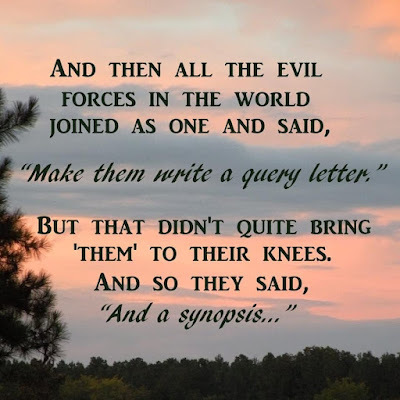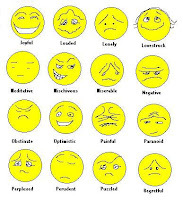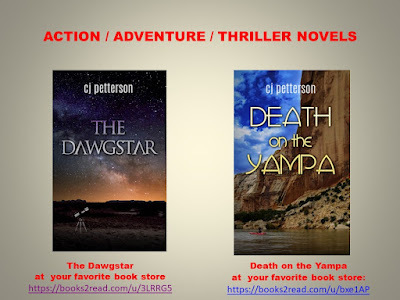Chapter synopses
cj Sez: I retrieved this post from my archives because I’mthinking about writing a synopsis for my work-in-progress. Yep, that’s right:in progress.

I read a comment that it might be easier to create thatdreaded synopsis as you finish a chapter or two rather than wait until you typeTHE END.
Clever idea. Write a chapter synopsis while each plot point is freshin my mind and then I can pull it all together when the story is ended. It’salways easier for me to edit than it is to stare at an empty page and try tothink of something. Anyway, in this post, I’mgoing to reprise some points I've discovered about writing a synopsis. Since I don’t do a formal outline for my stories (gasp), Ican use the synopsis as a form of outline. It will help me find any holes in mystoryline.
Since I don’t do a formal outline for my stories (gasp), Ican use the synopsis as a form of outline. It will help me find any holes in mystoryline.
Someone asked me once how I knew when I’d reached the end of mystory if I didn’t know where it was going. The reason I don’t outline isbecause once I’ve gone through that whole process, I feel as if I’ve writtenthe entire story. That takes away the adventure of writing for me, except in writing mysteries when I really have to plan it all out.
I don’t consider myself a “pantser” though. I do know how Iwant the story to start, and I do know how I want it to end. What I don’t know(or plan/plot) is the path the characters will take to get from beginning toend. Using that analogy, I call myself a “pathfinder.”
 I like the excitement offinding out—as I write—what kind of trouble I can create for my characters then figure out how to get them out of it. Kind of like running a maze. I write until I've solved all the characters' problems and gotten them out of their maze, then I'm done. The End.
I like the excitement offinding out—as I write—what kind of trouble I can create for my characters then figure out how to get them out of it. Kind of like running a maze. I write until I've solved all the characters' problems and gotten them out of their maze, then I'm done. The End.
I’ve talked with writers who say they have absolutely noproblem creating a synopsis. Not so me. I would love to find the one I safelyfiled away a couple of years ago, but I do remember some of the importantrules.
As I’ve said before, some rules are made to be broken, but first onemust know what the rules are. I wouldn’t, however, advise a novice writer tobreak any rules when submitting a manuscript, especially if the instructionsare spelled out on an agent’s or publisher’s website. And always, always usethe agent/publisher instructions for font and page layout format whether forstory submission or a proposal or a synopsis.
After typing the end to my WIP, I will tie my chapter synopses into a finalform, applying the following rules (or better, "cues"):
Start with a hook (the character or the inciting incident)and reveal the story premise.
Concentrate on the primary story line, the turning points,and their effect (internal and external) on the characters and do this inthe chronological order of the story.
This is where writing a synopsis for each chapter is veryhelpful.
Include primary characters byname. Use all capital letters the first time s/he is introduced within thesynopsis. Then be consistent with how the character is referred to in the restof the document.
For example, JOHN DOE might become Johnny for the remainderof the synopsis. Secondary characters can be described by what they do ratherthan by name . . . the sheriff, the teacher, the doctor.
It’s very important is to show the complete narrative arcfor the primary character.
 Write in active voice. Use strong verbs and words that showemotions, motivations, conflict, and tension.
Write in active voice. Use strong verbs and words that showemotions, motivations, conflict, and tension.
Don’t go into lengthy descriptions and backstory in asynopsis.
The synopsis should be written in the same tone (voice) asthe novel.
It looks soooo simple, doesn’t it? One, two, three, et al.,and done. Not so fast, Grasshopper.*
Just like every other writer who’s typed THE END on the lastpage of their novel, I’ll be trying to cram thousands of words and hundreds ofpages of manuscript into a concise document that is sometimes restricted tomaybe four or five pages. Though I have read that some might peak at eighteenpages, depending on who’s asking for the synopsis.(*The student character in the 1970s TV show “Kung Fu.”)
§§
Okay, that’s it fortoday. You-all guys keep on keeping on, and I’ll try to do the same. Raisingprayers for a happy and safe you and yours.
cj
Now some words from my sponsors:
Beach? Mountains?StayCay? It’s time to plan for those holiday and summer vacation downtimemoments when you can lose yourself in a book. My novels, THE DAWGSTAR and DEATHON THE YAMPA are available on Amazon or through your favorite eTailer andbookstore.
Got a library card? You can read the ebooks free fromHoopla.
Nota bene: AngelaTrigg, the RITA Award-winning author and owner of The Haunted Book Shop has afew signed copies of my paperback books in stock. TO ORDER, contact: https://www.thehauntedbookshopmobile.com/contact-us
➜ Follow me on ➜ Amazon: AmazonCentral Author Page➜ Facebook: https://www.facebook.com/CjPettersonAuthor➜ BookBub: https://www.bookbub.com/authors/cj-petterson➜ Goodreads: https://bit.ly/3fcN3h6

I read a comment that it might be easier to create thatdreaded synopsis as you finish a chapter or two rather than wait until you typeTHE END.
Clever idea. Write a chapter synopsis while each plot point is freshin my mind and then I can pull it all together when the story is ended. It’salways easier for me to edit than it is to stare at an empty page and try tothink of something. Anyway, in this post, I’mgoing to reprise some points I've discovered about writing a synopsis.
 Since I don’t do a formal outline for my stories (gasp), Ican use the synopsis as a form of outline. It will help me find any holes in mystoryline.
Since I don’t do a formal outline for my stories (gasp), Ican use the synopsis as a form of outline. It will help me find any holes in mystoryline.
Someone asked me once how I knew when I’d reached the end of mystory if I didn’t know where it was going. The reason I don’t outline isbecause once I’ve gone through that whole process, I feel as if I’ve writtenthe entire story. That takes away the adventure of writing for me, except in writing mysteries when I really have to plan it all out.
I don’t consider myself a “pantser” though. I do know how Iwant the story to start, and I do know how I want it to end. What I don’t know(or plan/plot) is the path the characters will take to get from beginning toend. Using that analogy, I call myself a “pathfinder.”
 I like the excitement offinding out—as I write—what kind of trouble I can create for my characters then figure out how to get them out of it. Kind of like running a maze. I write until I've solved all the characters' problems and gotten them out of their maze, then I'm done. The End.
I like the excitement offinding out—as I write—what kind of trouble I can create for my characters then figure out how to get them out of it. Kind of like running a maze. I write until I've solved all the characters' problems and gotten them out of their maze, then I'm done. The End.I’ve talked with writers who say they have absolutely noproblem creating a synopsis. Not so me. I would love to find the one I safelyfiled away a couple of years ago, but I do remember some of the importantrules.
As I’ve said before, some rules are made to be broken, but first onemust know what the rules are. I wouldn’t, however, advise a novice writer tobreak any rules when submitting a manuscript, especially if the instructionsare spelled out on an agent’s or publisher’s website. And always, always usethe agent/publisher instructions for font and page layout format whether forstory submission or a proposal or a synopsis.
After typing the end to my WIP, I will tie my chapter synopses into a finalform, applying the following rules (or better, "cues"):
Write the synopsis in third person, present tense.
Since my stories are written in past tense, I need to keepthat directive on a piece of paper taped to the monitor in front of me.
Start with a hook (the character or the inciting incident)and reveal the story premise.
I think of this as my “elevator pitch”—the twenty-fivewords and amount of time a writer has to impress an agent if caught on theelevator together.
Concentrate on the primary story line, the turning points,and their effect (internal and external) on the characters and do this inthe chronological order of the story.
This is where writing a synopsis for each chapter is veryhelpful.
Include primary characters byname. Use all capital letters the first time s/he is introduced within thesynopsis. Then be consistent with how the character is referred to in the restof the document.
For example, JOHN DOE might become Johnny for the remainderof the synopsis. Secondary characters can be described by what they do ratherthan by name . . . the sheriff, the teacher, the doctor.
It’s very important is to show the complete narrative arcfor the primary character.
How s/he felt at the beginning of the manuscript and how thecharacter is changed by the end of the story.
 Write in active voice. Use strong verbs and words that showemotions, motivations, conflict, and tension.
Write in active voice. Use strong verbs and words that showemotions, motivations, conflict, and tension. Don’t go into lengthy descriptions and backstory in asynopsis.
Unless a character’s physical description or age ispertinent to one of the story threads, keep focused on the nitty-gritty of themain story line.
The synopsis should be written in the same tone (voice) asthe novel.
I.E. if the novel is lighthearted, the synopsis should bealso.
It looks soooo simple, doesn’t it? One, two, three, et al.,and done. Not so fast, Grasshopper.*
Just like every other writer who’s typed THE END on the lastpage of their novel, I’ll be trying to cram thousands of words and hundreds ofpages of manuscript into a concise document that is sometimes restricted tomaybe four or five pages. Though I have read that some might peak at eighteenpages, depending on who’s asking for the synopsis.(*The student character in the 1970s TV show “Kung Fu.”)
§§
Okay, that’s it fortoday. You-all guys keep on keeping on, and I’ll try to do the same. Raisingprayers for a happy and safe you and yours.
cj
Now some words from my sponsors:
Beach? Mountains?StayCay? It’s time to plan for those holiday and summer vacation downtimemoments when you can lose yourself in a book. My novels, THE DAWGSTAR and DEATHON THE YAMPA are available on Amazon or through your favorite eTailer andbookstore.

Got a library card? You can read the ebooks free fromHoopla.
Nota bene: AngelaTrigg, the RITA Award-winning author and owner of The Haunted Book Shop has afew signed copies of my paperback books in stock. TO ORDER, contact: https://www.thehauntedbookshopmobile.com/contact-us
➜ Follow me on ➜ Amazon: AmazonCentral Author Page➜ Facebook: https://www.facebook.com/CjPettersonAuthor➜ BookBub: https://www.bookbub.com/authors/cj-petterson➜ Goodreads: https://bit.ly/3fcN3h6
Published on May 20, 2024 02:30
No comments have been added yet.
Book launch scheduled
DEADLY STAR is scheduled to launch on Feb. 18. You can't tell from this type font, but I'm excited!
DEADLY STAR is about a vaguely dysfunctional couple who, when sharing an imminent danger, find common DEADLY STAR is scheduled to launch on Feb. 18. You can't tell from this type font, but I'm excited!
DEADLY STAR is about a vaguely dysfunctional couple who, when sharing an imminent danger, find common ground in their love for each other. I hope the reader will find that as enjoyable to read as I did to write. Mirabel Campbell, the protagonist, might be called a nerd, but she's also sassy and determined. Robert (Sully) O'Sullivan is a ruggedly handsome CIA agent. On the flip side, he’s a bit of a bad boy and a liar.
As soon as I know when advance ordering is available for DEADLY STAR, I'll post it, here and on www.lyricalpens.com but please also check on Amazon.com and B&N.com.
...more
DEADLY STAR is about a vaguely dysfunctional couple who, when sharing an imminent danger, find common DEADLY STAR is scheduled to launch on Feb. 18. You can't tell from this type font, but I'm excited!
DEADLY STAR is about a vaguely dysfunctional couple who, when sharing an imminent danger, find common ground in their love for each other. I hope the reader will find that as enjoyable to read as I did to write. Mirabel Campbell, the protagonist, might be called a nerd, but she's also sassy and determined. Robert (Sully) O'Sullivan is a ruggedly handsome CIA agent. On the flip side, he’s a bit of a bad boy and a liar.
As soon as I know when advance ordering is available for DEADLY STAR, I'll post it, here and on www.lyricalpens.com but please also check on Amazon.com and B&N.com.
...more
- C.J. Petterson's profile
- 12 followers



